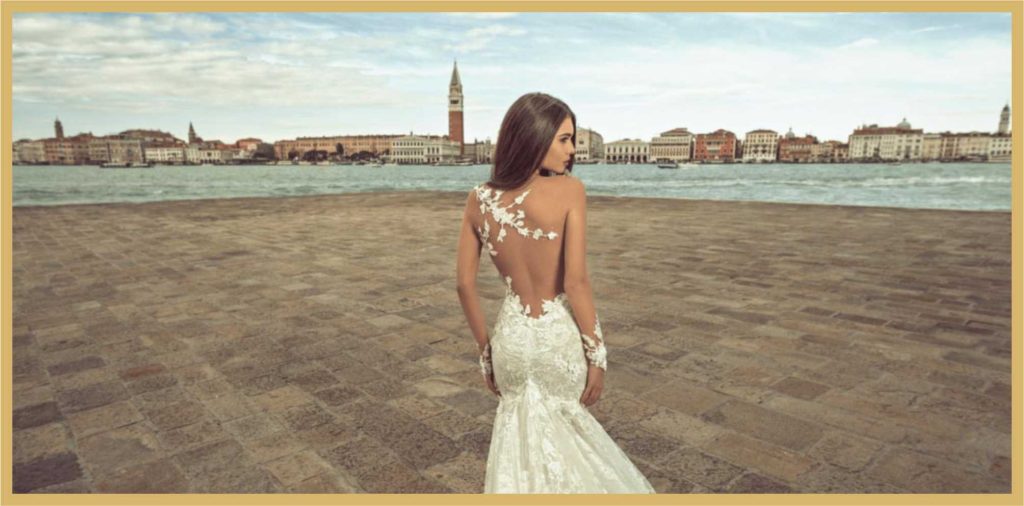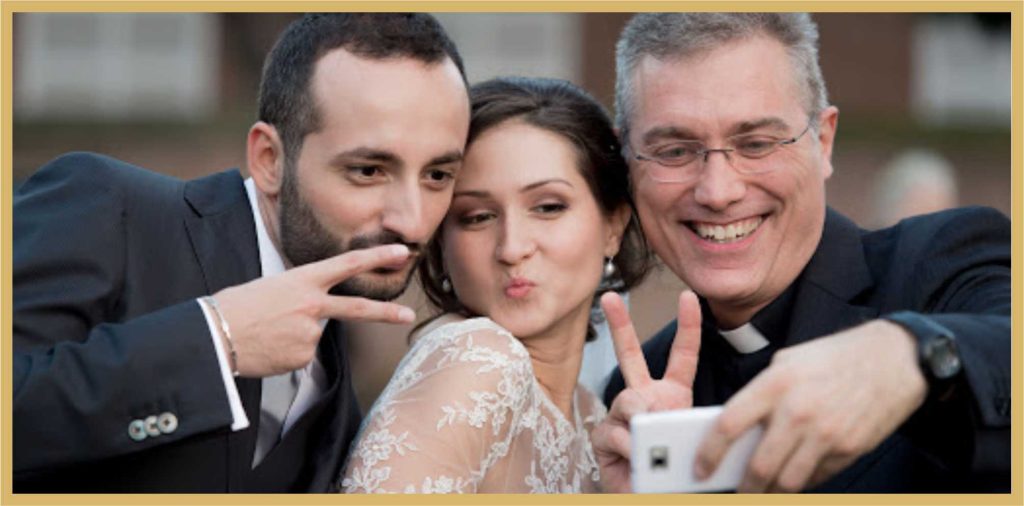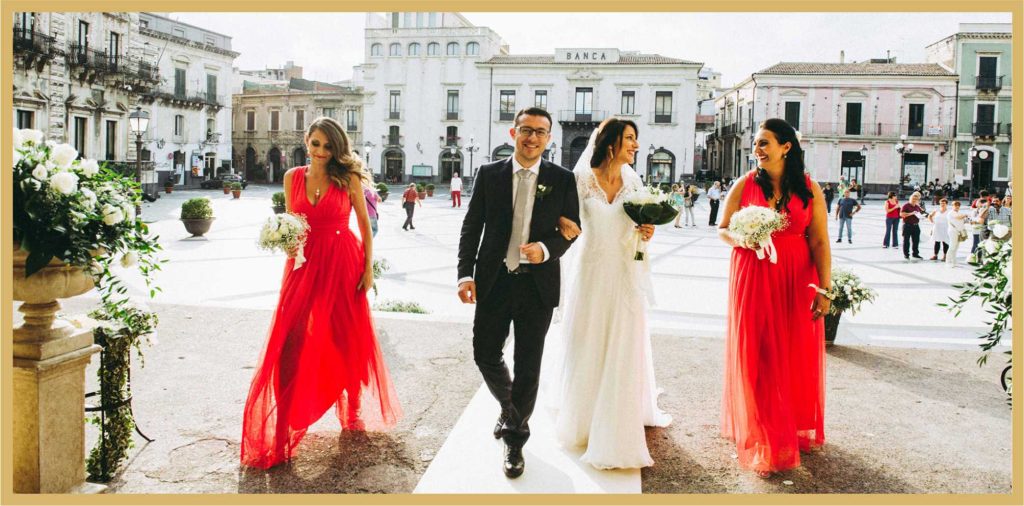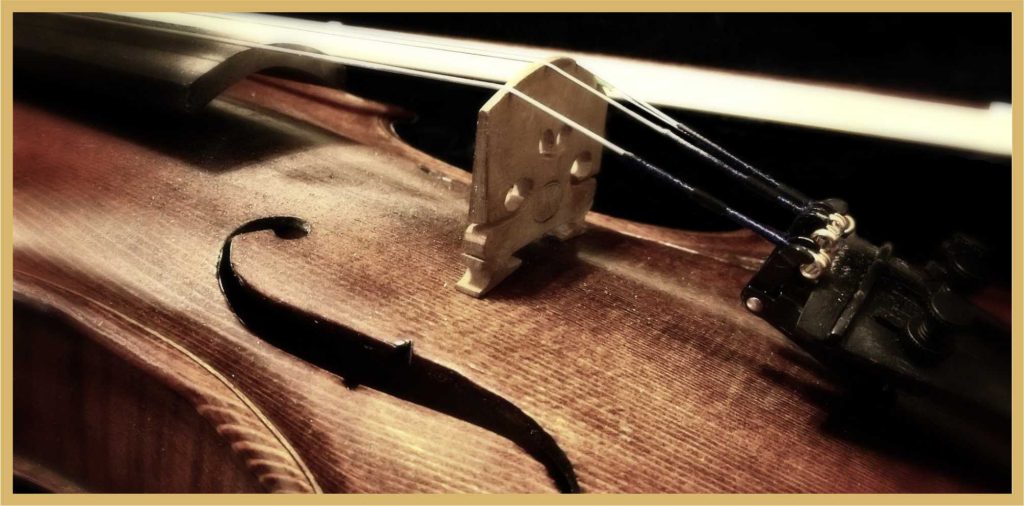Although civil marriages are soaring, according to the latest Istat report, more than half of Italians continue to say the most important Yes of their lives in front of a priest rather than in front of a municipal official.
Leading the ranking is southern Italy where tradition endures the most, where marriages performed at the altar are still prevalent, ranging from 86 percent in Basilicata to 53 percent in Sardinia, while in northern and central cities civil marriages are now in the clear majority, reaching peaks above 83 percent.
In this article, therefore, we want to provide guidance to all newlyweds who are about to take the big step through religious rite.
1.The bureaucratic aspects
First of all, in order to be married in the church, the bride and groom are required to participate in a premarital course, which consists of a spiritual preparation for the future life of the couple: here you can consult all the details about this necessary step, whose duration is usually two months, for a total of about ten meetings. For many it may seem like a waste of time, yet in some cases it may be useful to address certain topics and go into them in more depth.If then the person who supports the course management is a psychologist or has a lot of experience in human relations you may have some useful advice for the future.
Coming to the bureaucratic issue, the necessary documents are as follows:
- the certificate of baptism
- the confirmation certificate
- in some cases also the certificate of ecclesiastical free status
- The certificate of participation in the premarital course.
Additional information can be found in this article, “Documents for Religious Marriage.”
2.Timelines
“A serene married couple is bound to be a happy married couple-that is our motto!” The advice, therefore, is to arrange for the wedding paperwork well in advance: this will give you a lot of peace of mind and relieve you of further ‘undated’ commitments, and make you safe from mishaps that can ruin your Best Day. Although it is possible to organize an express wedding in as little as 6 months or even 3 months, it is always a good idea to move early. The first step is to choose the parish, which can be her parish, his parish, or the parish related to the new residence of the bride and groom-to-be. “Meet with the priest of your choice, also make arrangements to start the premarital course, visit the church where you will be married.
3.The liturgy of marriage
During the celebration of the Holy Mass, two in particular will be the moments dedicated to the wedding celebration: the renewal of baptismal promises, at the beginning of the religious service, and the actual rite of marriage, with the exchange of rings and wedding vows: it takes place after the homily and ends with the blessing to the bride and groom. Remember that unless specific exceptions are made, one cannot marry during Lent and Advent.
4.How to personalize the ritual
Among the hottest trends, we have seen how choosing the perfect wedding thread is crucial to give continuity and convey one’s style. You can personalize the Catholic rite, through choosing the readings from those provided by the priest or there are several websites that can help you in constructing the booklet; in addition, you can ask your guests to prepare intentions to be read during the church service, and of course you can read your own intentions. During the offertory moment, you can present items that have represented your love story, reading a brief explanation as these are brought to the altar. The greatest value of the sacred ceremony is the spiritual aspect: “take care of it as much as, indeed more than, any other; There is nothing more beautiful than two newlyweds moved and excited!” Do we often tell our wedding couples that marriage is the best gift you can give each other and yourselves? We also advise you to stick to three simple principles to ensure a heartfelt and engaging ritual:
- You accept and abide by the rules and customs of the church in which you are getting married-even if these prevent, for example, throwing rice or petals outside the church, complex arrangements, Gospel singing, photos during the central moment of the rite (note that these are all rules are at the discretion of the priest)
- Cultivate an honest and respectful relationship with the priest who will marry you, taking advantage of the engaged course but also involving him if he feels like it in a collaborative creation of the ceremony booklet.
- Don’t force your guests to participate in parts of the ceremony if you know they don’t believe in it and would be uncomfortable. In short, beyond traditions, rules and etiquette, love and respect are the answer to every situation!”
5.Church arrangements
Not only is the music aspect subject to constraints dictated by the environment in which the wedding will take place, but also the arrangements and decorations are often restricted by the priest.While for the location you will have some flexibility for what concerns floral decorations in the church, it often happens that priests impose certain guidelines for decoration by indicating ‘yes points’ and ‘no points’ for decorations. Talk it over with whoever will be handling the matter but keep in mind that it is never a good idea to transgress the rules of your host church. Rather, try to focus on the type of decoration by coordinating it with both the style of the church and the type of ceremony you have in mind. If then the professional to whom you have entrusted the task has already worked, as is often the case, in that particular church, he will know how to advise himself in order to achieve a result that is as much in line with your imagination as possible while respecting the current restrictions. Also remember that the gazes will be focused mainly on you, so the points of greatest impact will be: the church portal at the entrance and exit, the area in front of the altar, where you will stand the longest, and your seats.
So think about how to highlight these three particularly significant points.
Avoid having inconspicuous side niches set up or spots too low to be noticed, yes instead to balustrade decoration.
Last tip: Do not overload an already richly decorated cathedral (such as Baroque ones) and use flowers and greens in light tones to brighten a Romanesque chapel. What if the priest says no to rice on leaving the church? Patience! You can fall back on the Touch balloon (A large balloon that exploded by the bride and groom releases a series of smaller balloons) to match your wedding’s rouge.
Make an appointment with the priest orif you have a wedding planner go together to see the church and very politely inquire if what you want for the ceremony is feasible (flowers, music, time, etc.);Try to get his approval, so that you don’t find him on your wedding day placating florists or string quartet in the churchyard. Not all churches are allowed the same things, not all pastors are willing to indulge the bride and groom in everything. “Remember the sacredness of the ceremony, don’t clutter up the priest with misplaced exuberance, you will then have the whole day to give free rein to all your desires. “Good taste and measure must be your cornerstones!”

6.The choice of wedding dress
We mainly deal with music however we feel obliged to waste 2 words regarding the bride’s dress, in fact if you decide to choose a religious wedding you should definitely keep in mind that you will have to undergo some restrictions that this choice implies. Since this is a sacred place you need to be respectful of the traditions of the host place in other words, the bride’s dress should have her shoulders covered by a stole or veil, and – in the case of autumn weddings or weddings celebrated in winter, the outfit can be completed by a shrug, which will then be removed during the reception. As irresistible as a sexy wedding dress may be, it may not respect the sanctity of the venue, and create unpleasant embarrassments.
We recommend that you reserve a particularly low-cut or nude-effect dress for the reception. In recent years we have really seen everything, and that is why we recommend a certain ‘decorum’ to you brides, discouraging exaggerated transparencies, miniskirts, vertiginous necklines.
If you just can’t adjust your dress get a stole/bolerine to keep only during the church service; Also listen to the advice of the atelier that will provide the dress. He will definitely know how to direct and advise you for the best.
7.The outfit of the guests
Another parenthesis that is of little concern to us but on which we feel it is important to give some thought concerns wedding guests, and especially their ladies. Yeah, because while the choice of look for men is increasingly simple, or at least codified, the same cannot be said for women, a minefield area where it really only takes one misstep to ruin an outfit, or-horror of horrors! – Taking the leading role away from the bride.
By now, even stones know that white is absolutely banned even in case the bride has opted for a colorful dress! This is always true for the wedding guest, all the more reason you will need to consider appropriate attire for a church wedding. For guests, NO to total black or total white looks, NO to bare shoulders and NO to dresses that are too short. These should be well-established rules by now, but evidently many girls have a hard time assimilating these concepts: you don’t wear white to other people’s weddings!
We recommend that you carefully consider any indications contained in the invitations, as well as the type of the invitations-they, in themselves, provide much indication of the style and level of formality of the event.
Carefully choosing the outfit taking into account the dress code if imposed by the bride and groom, age, physique, location and time of the event is crucial. A pair of vertiginous heels displayed at a barefoot reception on the beach is just as tacky as a fuchsia mini in a gathered church.
8.The musical entertainment
Finally we enter our area of expertise, in fact when we talk about church weddings we also talk about musical accompaniment to enhance the different moments of the liturgy. In fact, musical entertainment is part of the liturgy and is one of the most important aspects because of its ability to move the bride and groom and their guests.
Music is an integral part of the religious ceremony and, if handled properly, can emphasize and give “pathos” to the important moments of the celebration. Live music is definitely the best choice, an organist, violin, harp, classical guitar or a singer singing ‘a cappella,’ choose the solution that best suits your wishes, but do not leave this important detail to chance. We at Team Wedding Symphony provide orchestral masters all of whom graduated from conservatories in the Veneto region with top honors; This guarantees a result that lives up to your expectations and the knowledge that you have entrusted professionals who specialize in ceremony music with the soundtrack of your YES.
Beware of space, however: “There are large churches and others that are more intimate and collected so in both cases it is useful to assess the space needed by the musicians: there is no point in wishing for a string quartet if the space does not allow it, however also consider compacting the pews by 10cm to recover 1 Mt in only 10 rows. Although this may seem like biased advice, we suggest that you allocate part of the budget to ‘musical entertainment, as we believe it is part of the rite, punctuating the timing and making everything much more exciting.
The choice approaching this decision-making aspect is really quite vast starting from the instruments that will accompany your ceremony, to the solo voices or the choir not to mention the specific choice of songs; In fact, there are religious songs that are just right for the wedding and others that are not at all. Get advice Choose those that are most akin to your style and your chosen readings.
9.The choice of photographer
Let’s go out of our own field again but we cannot avoid making a small parenthesis dedicated to the photographer for the ceremony; While it is very important to capture the most important moments of the ceremony, it should also be remembered that it is essential to be respectful of the function itself as well. After all, as we have seen here, the choice of photographer is one of the most important moments of the whole organization, as well as one of the aspects on which it is better not to save money: after all, relying on a professional photographer is a guarantee for those who do not want to miss anything on their most beautiful day.
It would be ideal for the photographer to get to know the priest a few hours beforehand, and to take care to avoid turning church and location into a movie set with dollies and direct flashes: the key element of a good professional lies precisely in his ability to be attentive and omnipresent, yet without letting his presence show. Invisible and careful in capturing every moment with discretion.
Also consider how many photographers will be present at the church: unthinkable to have only one photographer for a wedding over 50 people if you want a truly comprehensive service! Photographs are very important in any wedding, yet the professional, cannot and should not get in the way of the natural unfolding of the ceremony. “You’re not on a movie set and the scenes–you can’t repeat them!”

There are definite rules and restrictions on this so make sure the photographer you entrust with the service is aware of them;
I give you an excerpt of it below:
- Practitioners make early contact with the priest in charge of the church for appropriate arrangements. With the same they take a view of the church itself and its layout. Should the operators find the church lighting insufficient, agree with the priest on avalid solution for both.
- They curate respect toward ministers and the assembly, maintaining silence and discreet gesturesduring their time in the church.
- They wear clothes appropriate to the place and the ritual.
- Do not divert the attention of those present from the unfolding of the liturgical action by distracting them from the devout participation in it. In particular, they will limit travel to the bare minimum and make discreet use of flashes.
- When a Sacrament is administered during Mass, the workers will refrain from their exercise:
- During the proclamation of the readings and the homily;
- From singing the “Holy” to the “Our Father.”
- During the silence after communion.
- When a Sacrament is administered during the Liturgy of the Word, the operator will make arrangements with the pastor to film the moments of special emphasis.
- They will deposit their professional materials (various equipment, bags…) in a suitable place, defined with the priest in charge of the church.
- Only one photographer and one cameraman determined by the priest-esperson in charge of the church in consultation with the faithful celebrating a particular circumstance (Baptism, First Communion Mass, Confirmation, Marriage…) will be allowed at the celebration. The photographer and cameraman are in possession of a professional pass issued by the Bishop’s Curia. Operators coming from other diocesesmay perform the service by reason of the authorization granted by the home diocese and otherwise in compliance with these regulations.
- Should an operator without a professional card issued by the Bishop’s Curia(or a relative) be chosen, it is the duty of the priest in charge of the church to provide the same operator with the present regulations and ensure that he will abide by them.
- The professional card is issued by the Episcopal Curia to those who have participated in the presentation of these regulations, by the competent office it will be endorsed and, if necessary, renewed every three years; the service for liturgical pastoral care of the Episcopal Curia may eventually revoke it before its expiration for serious failures to comply with these regulations.
- The list of photographers who have signed these regulations will be kept at the office of the liturgical pastoral service for appropriate information to parishes.
10.Etiquette Pills
We are at the end of this decalogue, so how can we not conclude with some clever tricks that will really make your wedding different from all the others you have already attended. First:
- NO to appalling delays
- To intrusive musical accompaniments
- To smartphones in the hands of friends and family; Leave it to your wedding planner if you have one or the professionals you have hired to enhance your style in the ceremony as well. They will know, with taste, sensitivity and discretion, how to make you and your guests feel pampered as early as the church service. Speaking of smartphones and company, please note that a photographer is usually paid by the bride and groom for the service, so additional shots from wild iPhones or wannabe artist friends are not necessary.
We have seen uncles and cousins seriously get in the way of the professionals’ work, so if possible,we recommend that you warn guests in advance not to move from the pews during the ceremony and, if they really cannot resist the temptation of the shot, not to use the flash. These tips also and especially apply during the ceremony, so watch out for flashes, tags and hashtags!

- Last but not least and perhaps the most important point: the bride is expected in the church, with the guests seated and the groom in his place near the altar! Don’t misrepresent my words, I am not a stickler for rules and traditions, in fact I believe that every married couple should construct their wedding in their own image, but I insist on this point: there is nothing worse for a bride than entering an empty church or having to wait for “the herd” to enter amidst increasing chatter and an annoying background buzz! Not to mention, then, that photographers hate the chaos generated when guests rush to sit down as the bride tries to reach her groom. It is an important and solemn moment that guests must respect and that the bride and groom deserve to experience in the most romantic way possible.”
That said.
I hope you have found useful hints, ideas and tips on this article, and before we conclude we leave you with a few suggestions: in the invitations, do not forget to include the time of the religious service, anticipating it by 30 minutes so that guests can precede your arrival and settle comfortably in the pews; If you print the ceremony booklets, remember to personalize them with phrases that represent you: in addition to being a valuable aid in following the natural unfolding of the religious service, they will also be a sweet keepsake to cherish over time; If you plan to involve friends and relatives, give them advance notice so that they can rehearse their readings, averting small embarrassing moments, given the excitement and clutter of the dresses chosen for the ceremony especially by the young ladies.
I am Paolo Furlan founder of the music agencies Wedding Symphony specializing in ceremony music and Wedding Music Fun specializing in wedding music and entertainment. Follow our social channels to stay up to date with the latest news and get helpful tips on how to best plan your wedding!
More info awaits you on our blog.
Don’t let them pass you by.
Enjoy your reading and have a good life!


